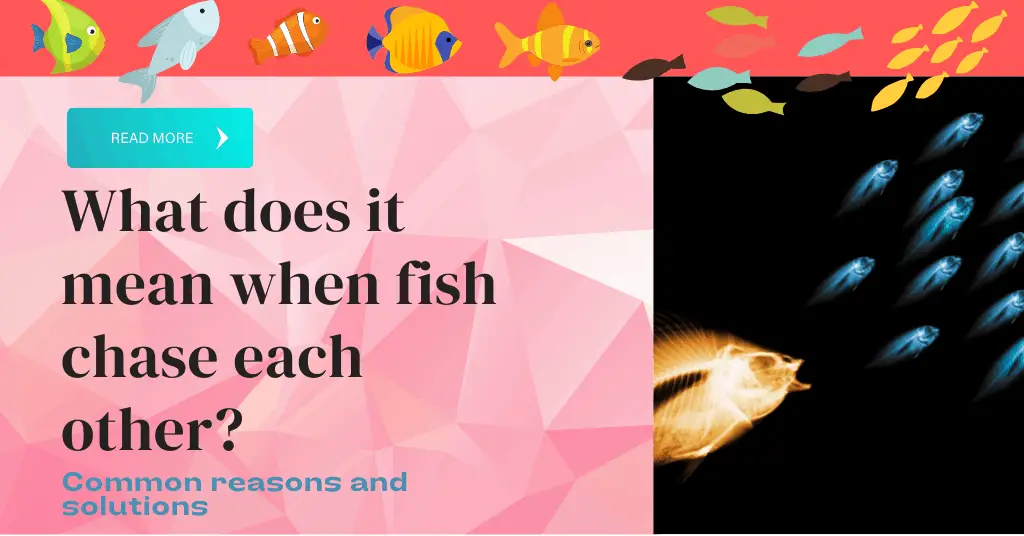Last Updated on July 4, 2021 by cmoarz
There are many reasons why fish might be chasing each other around in your aquarium. Sometimes it means nothing and sometimes it’s a sign of trouble. In this blog post, we will help you diagnose the reason your fish are acting this way, and how to solve the problem.
Why do fish chase each other around the tank?
Table of Contents
There are 4 reasons this happens. Incompatible tank mates, Courtship, dominance and bullying, and competition for food. Sometimes fish will also play with each other but the other reasons should be considered first as it could be considered an emergency.
let’s get into some of the details.
Incompatibility in tank mates
Sometimes people put fish in their community tanks and don’t realize they may not be compatible. Some species can be considered more aggressive than others and may have a problem with some of the other fish in their tank. If you notice your fish chasing each other around a lot, it could be because they are not compatible tank mates.
Spotting incompatible tankmates are super easy once you know what to look for. Do your fish have different colors or body shapes?
Are they of the same size and swim at the same speed, depth, and height in the water column?
Are they different species?
Some of these might indicate they are incompatible with each other.
When in doubt, A simple google search for the species of fish in your community tank will easily tell you everything you need to know about their compatibility issues and whether or not they should be housed in different tanks or not.
However, there is much more to talk about when it comes to aggression and bullying and how to spot it.
To show dominance territoriality, or just being a bully
Aggressive fish are aggressive. That is why they have the label aggressive. If they are chasing each other around it’s most likely because one or both of them want to dominate the tank.
Dominance and bullying in fish can be tricky for us humans to spot sometimes, but there are certain things you should look out for that will help you figure out what may be bothering your fish.
- Do you see any injuries on the fish?
A common injury is pieces of tail fin missing, nips on an antenna or missing antennas entirely (for snails or fish with antenna), or maybe grievous bodily wounds.
- Are they always attacking one specific fish in your tank and never anyone else?
This is a sure sign of bullying unless they are the same species, which could indicate mating. We get into that more below.
- Are they hiding in one spot of the tank and being timid?
Is the fish that is being harassed staying in 1 area of the tank, perhaps in a corner or around the filter area? Does it not try to venture out, or does it look like it might be hesitant to get food at feeding time?
These are also glaring signs of bullying.
Courtship and breeding
Of course, On the lighter side of things, if fish are the same species (and sometimes even when they aren’t) they could be displaying normal mating behaviors.
If you notice what appears to be courtship rituals such as the fish swimming back and forth in front of each other, their fins erect or spread out, then it is most likely mating.
It should also be noted that having 2 males or 2 females inside the tank can also cause mating-related aggressions. Sometimes this is nothing more than chasing each other out of their territory, But it could easily be much more serious.
Look for injuries as that’s the biggest tell.
Competition for food
Competition for food has a lot of variables attached to it. Between bottom feeders, mid feeders and top feeders, life feeders, pellet feeders, and flake feeders, A lot can go wrong in what might seem like a simple task.
Larger fish can overeat everyone else’s food, And sometimes smaller faster fish can outcompete a larger fish, making it starve.
Bottom feeders will sometimes take what they want from higher-level fish because there really isn’t anything stopping them – oftentimes bottom feeders outcompete others for food too.
It once again comes back to incompatibility.
The best way to diagnose feeding issues is to watch what the fish are doing.
Do they all eat at once and then leave?
Is there a negative interaction with what one or more of them does during feeding time, such as chasing after food that was dropped by another fish?
If you’re seeing any odd behavior around feedings it might be worth looking into ways to solve those issues, such as separating different species of fish in the same tank during feeding time, Or hand-feeding individual fish that are having issues with competition.
By simply dropping food in front of a fish who might not be able to compete with others is a great way to deal with this issue.
It’s also wise to consider a permanent move to a new tank and address those compatibility issues at the root.
They are just playing (Yes, fish do play!)
One of the most common misconceptions is that fish cannot play.
This couldn’t be farther from what is actually happening in a tank. Fish are constantly interacting with one another, and when they do it’s oftentimes playful interactions such as chasing each other around or bumping into one another on purpose to get them going.
It’s also a way for fish to communicate with each other.
If you see what seems to be one fish chasing another and they just keep going. It’s still important to watch these interactions closely, But if the fish are not displaying any signs of stress or damage to their bodies then it could easily just be simple “fish play”.
In conclusion:
Fish chasing each other around the tank can have a variety of meanings, from mating to bullying.
It’s important to watch what is happening closely when this happens and know what you are dealing with so that it doesn’t escalate into something more serious.
How do I know if my fish are fighting?
10 signs your fish might be fighting include:
1) Spots or lesions on the body
2) Tumor-like growths
3) Bleeding from the mouth and gills
4) Torn fins, eyes, or especially other damaged body parts that should not be able to regenerate
5) Disoriented swimming pattern (swimming in circles, straight up and down, wobbly movement back and forth…)
6) Loss of appetite
7) Enlarged abdomen or bloating around the stomach region
8 ) Cloudy eye color change
9) Open sores on top of the head
10) Visible breathing difficulty
How do I stop my fish from chasing each other?
I would start by watching what the behavior of the fish is. If the chasing is continuous and without injury, then it could just be playing or mating that should not be interrupted.
I would also try to separate the fish to see if this solves the issue or give hand-feeding a try to see if this alleviates competitive behaviors of food acquisition. If these are unsuccessful, then it might be time to move them into a new tank with other fish that have similar capabilities and temperaments.
An option to consider is sectioning off than tank, however, this option does have its own drawbacks:
- The fish will not be able to swim as much.
- It can lead to a less sense of security in the tank.
- There is also a lot more cleaning to do with this option. The division can prevent the filter/skimmer from being able to do its job.
- Another issue is if the tank is too small for sectioning. For example, if you have a really large labyrinth fish and you section off the tank, then they will not have enough room to swim around freely as their instincts tell them to do so.
- Fourthly, these restrictions will limit what type of plants you can include in the tank.
So, as for what to do when fish are chasing each other, it might be as simple as giving them their own space during feedings or addressing compatibility issues that could eventually lead to aggression.
Why are all my goldfish chasing one fish?
One of the most common questions is why goldfish gang up on other fish. If a tank is overcrowded, then this can cause a lot of aggressive behavior where one fish ends up getting “picked on.” This is because they are not able to find enough food and they have an increased level of stress in their bodies from being so crowded.
The best thing to do if you have a fish that is constantly getting picked on or bullied by other tank mates is to remove them from the tank.
Put them in their own tank for a while, or add them to an understocked tank with other fish that are similar in size and temperament.
This will give them a chance to get food more easily, have less stress on their bodies, and be able to assert themselves without being bullied constantly by larger or more dominant fish.
What does it mean when a fish goes crazy?
If your fish seem to be going crazy, it could be a sign of a disease or illness.
Fish that are not feeling well might have a variety of symptoms. These can include swimming in circles, erratic swimming pattern, loss of appetite, and swollen abdomen..
- Fin Rot
- Dropsy
- Ich (white spot disease)
- Red Spot Disease
- Hole-in-the-Head Disease
About
Owner of AquariumGravel.com and also owner of actual Aquarium Gravel believe it or not! ;). Setting up beautiful aquarium sceneries and habitats since I was very young. Enjoy!
- Web |
- More Posts(290)

